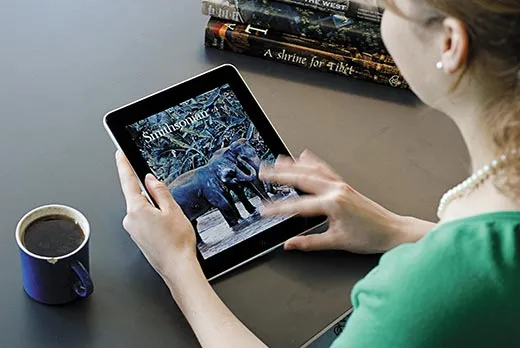Reading in a Whole New Way
As digital screens proliferate and people move from print to pixel, how will the act of reading change?
/https://tf-cmsv2-smithsonianmag-media.s3.amazonaws.com/filer/iPad-with-Smithsonian-first-cover-631.jpg)
America was founded on the written word. Its roots spring from documents—the Constitution, the Declaration of Independence and, indirectly, the Bible. The country’s success depended on high levels of literacy, freedom of the press, allegiance to the rule of law (found in books) and a common language across a continent. American prosperity and liberty grew out of a culture of reading and writing.
But reading and writing, like all technologies, are dynamic. In ancient times, authors often dictated their books. Dictation sounded like an uninterrupted series of letters, so scribes wrote down the letters in one long continuous string, justastheyoccurinspeech. Text was written without spaces between words until the 11th century. This continuous script made books hard to read, so only a few people were accomplished at reading them aloud to others. Being able to read silently to yourself was considered an amazing talent. Writing was an even rarer skill. In 15th-century Europe only one in 20 adult males could write.
After Gutenberg’s printing press came along around 1440, mass-produced books changed the way people read and wrote. The technology of printing expanded the number of words available (from about 50,000 words in Old English to a million today). More word choices enlarged what could be communicated. More media choices broadened what was written about. Authors did not have to compose scholarly tomes but could “waste” inexpensive books on heart-rending love stories (the romance novel was invented in 1740), or publish memoirs even if they were not kings. People could write tracts to oppose the prevailing consensus, and with cheap printing those unorthodox ideas could gain enough influence to topple a king, or a pope. In time, the power of authors birthed the idea of authority and bred a culture of expertise. Perfection was achieved “by the book.” Laws were compiled into official tomes, contracts were written down and nothing was valid unless put into words. Painting, music, architecture, dance were all important, but the heartbeat of Western culture was the turning pages of a book. By 1910 three-quarters of the towns in America with more than 2,500 residents had a public library. We became a people of the book.
Today some 4.5 billion digital screens illuminate our lives. Words have migrated from wood pulp to pixels on computers, phones, laptops, game consoles, televisions, billboards and tablets. Letters are no longer fixed in black ink on paper, but flitter on a glass surface in a rainbow of colors as fast as our eyes can blink. Screens fill our pockets, briefcases, dashboards, living room walls and the sides of buildings. They sit in front of us when we work—regardless of what we do. We are now people of the screen. And of course, these newly ubiquitous screens have changed how we read and write.
The first screens that overtook culture, several decades ago—the big, fat, warm tubes of television—reduced the time we spent reading to such an extent that it seemed as if reading and writing were over. Educators, intellectuals, politicians and parents worried deeply that the TV generation would be unable to write. But the interconnected cool, thin displays of the second wave of screens launched an epidemic of writing that continues to swell. The amount of time people spend reading has almost tripled since 1980. By 2008 more than a trillion pages were added to the World Wide Web, and that total grows by several billion a day. Each of these pages was written by somebody. Right now ordinary citizens compose 1.5 million blog posts per day. Using their thumbs instead of pens, young people in college or at work around the world collectively write 12 billion quips per day from their phones. More screens continue to swell the volume of reading and writing.
But it is not book reading. Or newspaper reading. It is screen reading. Screens are always on, and, unlike with books we never stop staring at them. This new platform is very visual, and it is gradually merging words with moving images: words zip around, they float over images, serving as footnotes or annotations, linking to other words or images. You might think of this new medium as books we watch, or television we read. Screens are also intensely data-driven. Pixels encourage numeracy and produce rivers of numbers flowing into databases. Visualizing data is a new art, and reading charts a new literacy. Screen culture demands fluency in all kinds of symbols, not just letters.
And it demands more than our eyes. The most physically active we may get while reading a book is to flip the pages or dog-ear a corner. But screens engage our bodies. Touch screens respond to the ceaseless caress of our fingers. Sensors in game consoles such as the Nintendo Wii track our hands and arms. We interact with what we see. Soon enough, screens will follow our eyes to perceive where we gaze. A screen will know what we are paying attention to and for how long. In the futuristic movie Minority Report (2002), the character played by Tom Cruise stands in front of a wraparound screen and hunts through vast archives of information with the gestures of a symphony conductor. Reading becomes almost athletic. Just as it seemed weird five centuries ago to see someone read silently, in the future it will seem weird to read without moving your body.
Books were good at developing a contemplative mind. Screens encourage more utilitarian thinking. A new idea or unfamiliar fact will provoke a reflex to do something: to research the term, to query your screen “friends” for their opinions, to find alternative views, to create a bookmark, to interact with or tweet the thing rather than simply contemplate it. Book reading strengthened our analytical skills, encouraging us to pursue an observation all the way down to the footnote. Screen reading encourages rapid pattern-making, associating this idea with another, equipping us to deal with the thousands of new thoughts expressed every day. The screen rewards, and nurtures, thinking in real time. We review a movie while we watch it, we come up with an obscure fact in the middle of an argument, we read the owner’s manual of a gadget we spy in a store before we purchase it rather than after we get home and discover that it can’t do what we need it to do.
Screens provoke action instead of persuasion. Propaganda is less effective in a world of screens, because while misinformation travels fast, corrections do, too. On a screen it is often easier to correct a falsehood than to tell one in the first place; Wikipedia works so well because it removes an error in a single click. In books we find a revealed truth; on the screen we assemble our own truth from pieces. On networked screens everything is linked to everything else. The status of a new creation is determined not by the rating given to it by critics but by the degree to which it is linked to the rest of the world. A person, artifact or fact does not “exist” until it is linked.
A screen can reveal the inner nature of things. Waving the camera eye of a smartphone over the bar code of a manufactured product reveals its price, origins and even relevant comments by other owners. It is as if the screen displays the object’s intangible essence. A popular kid’s toy (Webkinz) instills stuffed animals with a virtual character that is “hidden” inside; a screen enables children to play with this inner character online in a virtual world.
As portable screens become more powerful, lighter and larger, they will be used to view more of this inner world. Hold an electronic tablet up as you walk along a street, and it will show an annotated overlay of the real street ahead—where the clean restrooms are, which stores sell your favorite items, where your friends are hanging out. Computer chips are becoming so small, and screens so thin and cheap, that in the next 40 years semitransparent eyeglasses will apply an informational layer to reality. If you pick up an object while peering through these spectacles, the object’s (or place’s) essential information will appear in overlay text. In this way screens will enable us to “read” everything, not just text. Last year alone, five quintillion (10 to the power of 18) transistors were embedded into objects other than computers. Very soon most manufactured items, from shoes to cans of soup, will contain a small sliver of dim intelligence, and screens will be the tool we use to interact with this transistorized information.
More important, our screens will also watch us. They will be our mirrors, the wells into which we look to find out about ourselves. Not to see our face, but our status. Already millions of people use pocketable screens to input their location, what they eat, how much they weigh, their mood, their sleep patterns and what they see. A few pioneers have begun lifelogging: recording every single detail, conversation, picture and activity. A screen both records and displays this database of activities. The result of this constant self-tracking is an impeccable “memory” of their lives and an unexpectedly objective and quantifiable view of themselves, one that no book can provide. The screen becomes part of our identity.
We live on screens of all sizes—from the IMAX to the iPhone. In the near future we will never be far from one. Screens will be the first place we’ll look for answers, for friends, for news, for meaning, for our sense of who we are and who we can be.
Kevin Kelly’s book What Technology Wants will be published in October.

